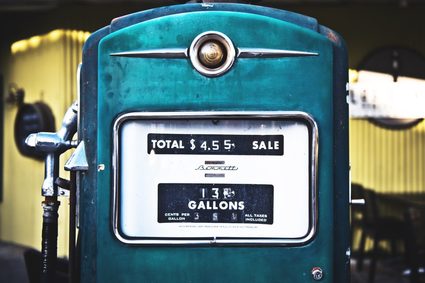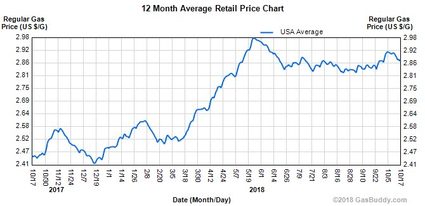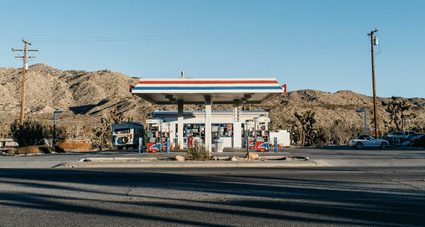Gas Calculator
This gas calculator is a handy tool for every driver who, when planning a trip, asks how much gas will I use? We prepared the gas estimator to help you find out how much fuel you will use on a car trip and how much it will cost you.
Our gas cost calculator is versatile and offers more than other web-based fuel cost calculators (e.g., splitting the gas cost). All you need to do is enter the driving distance and the average fuel economy of your car — then all the math is done automatically! In fact, your biggest concern will be how much gas costs at your nearest gas station.
That's not all, though. In the corresponding article, you can find information about gas prices today, gas price history, and gas price increases. Also, check out the best fuel economy cars and how to do eco-drive properly. Finally, a user-friendly tutorial will ensure you're using the gas calculator properly.
How much gas will I use?
Our gas estimator operates on a very simple premise:
-
Determine the distance you are about to travel. Let's say
295 km. -
Find out what's your fuel economy. Let's use
8 l/100 km. -
To work out how much fuel you will use in total, divide your distance by 100 (because we are looking at the fuel use every 100 km), so:
295 / 100 = 2.95and then multiply it by your combustion, so by 8:2.95 × 8 = 23.6. Now you know that you will use 23.6 liters of fuel.
If we want to take this one step further and find out how much this trip will cost us:
-
Determine the price of the fuel. Let's say
1.6 €/L. -
To find out the total price, multiply the total amount of fuel you will use by its price, so:
23.6 l × 1.6 €/L = €37.76. -
Now you know how to calculate the fuel use and its cost on your own, or you could use our gas calculator to make it so much easier and faster!
Splitting the gas cost
We finally know the answer to the question: how much gas will I use? However, we often travel with other passengers, so there is no need to pay for gas only by ourselves, we can split the cost among all passengers instead. All those calculations can be working awkward, so to spare you time and effort, our gas calculator can do it for you:
- Find out the total fuel cost. Let's use the example above of
€37.76. - Determine how many people are there. Let's say
4. - Divide the total price by the number of people to work out each person's share:
€37.76 / 4 = €9.44or let our gas estimator do it for you!
Cost of gas

Every car user spends money on gas. It is one of the most noticeable vehicle-related expenses. You can drive a car that has old tires, but without a full fuel tank, you will not travel far. So, it is evident that we quickly notice any increase in fuel price. According to the American Automobile Association (AAA), the average driver spends $3000 on fuel annually.
Gasoline prices are not determined just by the price of crude oil. Let's take a closer look at it. According to the Energy Information Administration (EIA), the average price of a gallon of regular gas in May 2014 was about $3.67. For the week of June 23, it would set you back $3.70. A French driver would have paid around $7.83, a British one $8.94. In Norway, which produces 1.8 million barrels of oil per day, a gallon of gas reached $9.90.
Gas prices and taxes
According to the EIA data from May 2014, the costs of producing crude oil account for only 65% of the average gas price. The next 12% are taxes (federal, state, and local), and another 11% for distribution and marketing. Refining accounts for about 13% of the gasoline price.
A big part of the gas price is taxes. The U.S. federal government established an 18.4 cents tax on gasoline and 24.4 cents on diesel. Without taxes, a gallon of gasoline is more expensive in the USA than in the U.K. ($3.18) and France ($3.37). There are also local and state taxes to consider. According to the Tax Foundation, if you are buying gas in New York State, you would pay the highest taxes in America (50.6 cents per gallon in 2013). The lowest taxes are in Alaska, where most of America's oil comes from — they are 8 cents.
Gas price history
Below you will find . Check the fluctuations of a gas price over the last seventeen years.
Year | Price | Year | Price |
|---|---|---|---|
2017 | 2.42 | 2003 | 1.56 |
2016 | 2.14 | 2002 | 1.35 |
2015 | 2.43 | 2001 | 1.42 |
2014 | 3.36 | 2000 | 1.48 |
2013 | 3.51 | 1999 | 1.14 |
2012 | 3.62 | 1998 | 1.03 |
2011 | 3.52 | 1997 | 1.20 |
2010 | 2.78 | 1996 | 1.20 |
2009 | 2.35 | 1995 | 1.11 |
2008 | 3.25 | 1994 | 1.08 |
2007 | 2.80 | 1993 | 1.07 |
2006 | 2.57 | 1992 | 1.09 |
2005 | 2.27 | 1991 | 1.10 |
2004 | 1.85 | 1990 | 1.30 |
Gas price increase
Gas prices are not stable and tend to fluctuate over time. These variations may be driven by many different factors, e.g., consumer fears over refining capacity. There are also economic factors, for example, a non-stable geopolitical situation (especially near oil-producing nations) or the risk of an oil-supply interruption.
To illustrate this principle, let's go back in time to 2005 when Hurricane Katrina hit much of the refining capacity along the Gulf Coast. Many refineries had to be closed, which caused a decrease in oil supply and, automatically, a high increase in gas prices. That year began with the average monthly gas price at $2.27 and finished at $2.76 but within the general upward trend. In September, there was a peak of up to $3.47 due to fears about the gasoline supply — this is the first time in history that gas prices exceeded the $3 threshold.
Even though the supply met the demand shortly after, gasoline suppliers weren't inclined to lower the prices as their customers got used to new prices. As a result, the price of gasoline has been kept high since the hurricane.
Gas price today
According to the Energy Information Administration, USA produces about 12% of the world's oil, which amounts to 2.7 billion barrels per day. That makes the United States one of the major oil-producing countries, up there with the likes of Saudi Arabia and Russia. However, the U.S. is also one of the biggest consumers of gasoline on a per capita basis, with approximately 1.22 gallons of gas per person daily. Gasoline is often regarded as a key driver of a country's economy. It is the main fuel used in passenger vehicles and the automotive fleets of small and large businesses.
Let's take a look at a worldwide gasoline prices comparison (in U.S. dollars per gallon). Fuel prices vary from a few cents to over 7 dollars per gallon. Gas prices in the U.S. were at the level of $2.99, while in Germany, they were considerably higher — $6.43. We can observe that, generally, gas prices in Europe are much higher than in America. Norway is the infamous world leader in gas prices at $7.82 per gallon. This is over 2.6 times more than in the USA and... 261 times more than in Venezuela ($0.03).

Fuel economy
We all wish we didn't have to spend so much on gas and would like to keep that money in our wallets instead. Check out the tips below if you want to save more money while fueling your car:
-
Check prices online — nowadays, there are many websites that provide daily updated gas prices in your neighborhood. Spending a little bit of time on an Internet check will allow you to plan a route for a gas stop at the station with the best prices. Try to do it for a month or two, and you will notice which stations consistently offer lower prices, and which tend to raise them.
-
Stay away from the highway — the stations which are located close to big roads are often the easiest to reach and prompt you their good quality coffee and meals. Keep in mind that probably you will pay more (sometimes much more) just because of the good location of the business.
-
Small, private stations — are a good alternative. Owners are not affiliated with big brands which take some of the income because of brand recognition. The quality of gas has to be compliant with standards, so you shouldn't be concerned about it.
-
Plan your purchase — try to avoid the situation when you are forced to fill up by the fuel indicator on your dashboard. You would probably have to stop at the nearest gas station; hopefully not one close to the highway.
-
Join the club partnership — most gas companies offer club partnerships. Being a club member enables you to recoup some money if you refuel at their gas stations regularly. Usually, you collect points when filling up, and then you can exchange them for discounts or gifts.

Eco-drive
Because of rising fuel prices more and more motorists are conscious of getting the maximum efficiency from their cars. Eco-driving is a way of driving that reduces fuel consumption, gas emissions, and accident rates. This term is the synonym for driving in a smart, smooth, and safe way that leads to an average fuel savings of 5-10%. Keep in mind — good driving is eco-driving.
If you are interested, follow the rules below:
- Anticipate the traffic flow:
Look ahead on the road as far as you can and try to anticipate the flow of traffic. Maintain a larger safety distance from other cars to increase your scope of the traffic. Use this knowledge to get the most out of your vehicle's momentum (in gear or neutral), accelerating and braking smoothly.
🙋 Learn how to estimate traffic flow in the traffic density calculator.
-
Maintain a steady speed at low RPM:
Drive gently, using the highest possible gear at low RPM. Avoid driving at excessive speeds. Try to keep the speed steady and avoid unnecessary braking and acceleration. -
Shift up early:
Change to a higher gear at around 2000 RPM. -
Check tires pressures frequently:
Ensure your tires are properly inflated. Low tire pressure is a safety risk and a waste of fuel. -
Avoid dead weight and aerodynamic drag:
Remove heavy objects that you don't use from your car (for sure you have some). Also, keep windows closed while driving on the motorway — it helps to improve the fuel economy. -
Use air-conditioning sparingly:
Using the AC unnecessarily is a waste of money because keeping it on increases fuel consumption. -
Share your car:
One of the best ideas to save money. Just one additional passenger would reduce your trip expenses by 50%.
Best fuel economy cars
“New vehicles offer the latest designs, cutting-edge technologies, and warranties that offer peace of mind, but car owners that like to change vehicles frequently should be thinking about the resale value – not just the purchase price – when choosing their next ride.”
John Nielsen, American Automobile Association's (AAA) managing director of Automotive Engineering and Repair.
The latest annual AAA’s analysis shows a shift in consumers' preferences. We can observe an increased appetite for SUVs cars and pickup trucks and a decreased demand for sedans.
This results in higher car depreciation costs (up to 13% in comparison to last year) for these ex-popular cars. Electric and hybrid vehicles have also increased in their popularity — 20 percent of Americans (15% in the previous year) say they are likely to buy an electric car as their next vehicle. It is not surprising — driving "green" cars is going to be more and more affordable. This is because of the much lower fuel and maintenance charges.
Research conducted by AAA shows the average cost of owning and operating a new vehicle in 2018. The study is based on the cost of fuel, maintenance, repairs, insurance, and taxes. 45 top-selling 2018 model year cars were taken into account across nine categories. The databases on 15,000 miles driven annually.
Vehicle type | Annual cost |
|---|---|
Small sedan | $6,777 |
Medium sedan | $8,866 |
Large sedan | $9,804 |
Small SUV | $7,869 |
Medium SUV | $9,697 |
Minivan | $9,677 |
pickup truck | $10,215 |
Hybrid | $7,485 |
Electric vehicle | $8,384 |
Average | $8,849 |
New cars are attractive to buyers because of the newest technology and electronics inside, various accessories, and a multitude of configuration options. However, they are not the best economical choice for some customers. For those who look for alternatives to new car ownership or ways to minimize operating costs should take a look at the tips below:
-
Buy a pre-owned car — slightly used vehicle in good condition is an affordable choice. Ownership costs are significantly lower, and the vehicle can still be safe, reliable, and perfect for driving.
-
Fuel responsibly — avoid wasting money on premium grade gasoline (unless your vehicle requires it) and on tanking up at expensive gas stations (e.g., those near highways).
-
Take care of your car — in general, spending money on routine maintenance will save you money.
-
Drive eco — when gas prices rise, small changes in your driving style could make a significant difference to your wallet.
Cars with great gas mileage used to have a reputation for being underpowered and small. However, the latest technologies, from plug-in hybrids to weight-saving measures and new solutions applied to engine construction, helped to change it. Nowadays, it means that nearly any kind of vehicle can be efficient without compromising space, comfort, or fun. Take a look at the top 15 best fuel economy cars:
- Toyota Prius Prime (2018)
- Hyundai Ioniq PHEV (2018)
- Honda Clarity PHEV (2018)
- Chevrolet Volt (2018)
- Kia Niro PHEV (2018)
- Kia Optima PHEV (2018)
- Hyundai Ioniq Blue (2018)
- Toyota Prius Eco (2018)
- Toyota Camry Hybrid LE (2018)
- Kia Niro FE (2018)
- Honda Accord Hybrid (2017)
- Chevrolet Malibu Hybrid (2018)
- Ford Fusion Hybrid (2018)
- Hyundai Sonata SE Hybrid (2018)
- Kia Optima Hybrid (2018)
Cost of gas for trip
You are planning a trip, and you are wondering how to get there. Usually, if the distance is not too big, traveling by car is fast and comfortable. Moreover, it is often cheaper than flying or even taking a train. But is it always? Finding the answer involves the current price of gasoline, your car's fuel efficiency, the distance, and some other road fees.
While planning a trip by car, first, you should find out what your car's fuel economy is (you can do that with our mpg calculator). Then, knowing the trip distance, you can use the fuel cost calculator and easily find out if it is affordable for you to use a car for the trip. Remember, you can easily reduce the costs of gas by finding cheap gas stations on the way and by taking more friends with you who can chip in for the fuel.
FAQs
Why do gas prices go up?
Gas prices may go up for a number of reasons:
- Restricted supply of oil;
- Inflation;
- Increased taxes; and
- The seller wished to increase their profit margins.
Does cruise control save gas?
Yes, cruise control saves gas, but only on flat roads. This is because it prevents unnecessary acceleration and deceleration, which can eat more fuel by the sudden shifts in the engine's demands. However, when using cruise control to climb hills, it cannot anticipate when you'll reach the top of the hill and so will keep the gas on for longer than you would.
How much will my drive cost me?
To find out how much your drive will cost, follow these steps:
- Find the distance you have to travel and the fuel efficiency of your vehicle.
- Multiply these two figures together. Ensure that the two distance units are the same. This result will give you the total fuel used.
- Multiply the total fuel burned by the price of fuel. The two units of volume need to be the same.
- The result is the total cost of your drive.